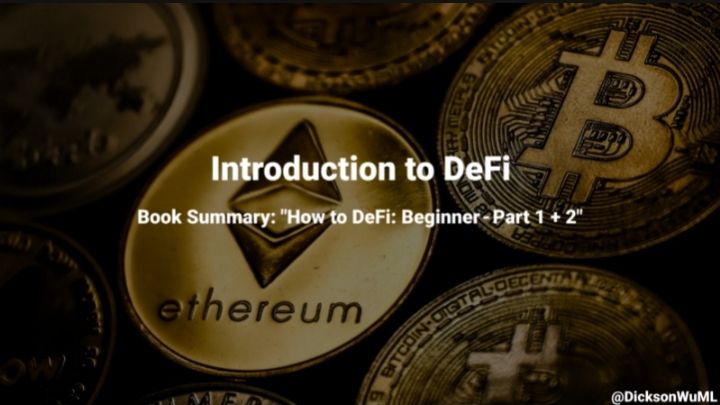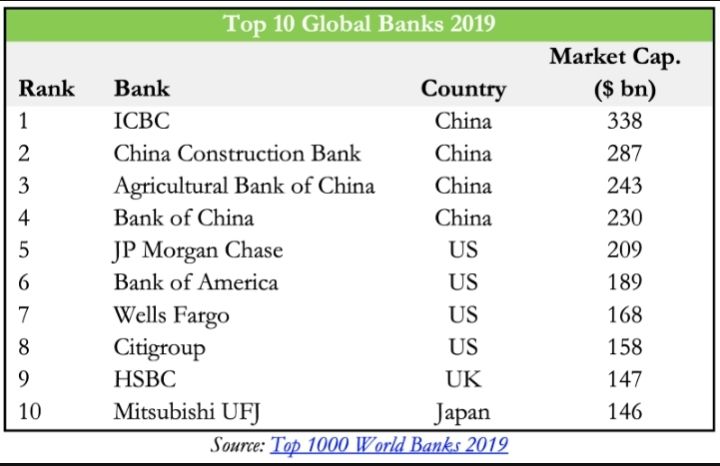Chapter 1: The Traditional Financial Institutions

Let’s start with the regular banks. They’re the core of the financial industry — facilitating payments (deposits, withdrawals, transfers), giving out loans, and more! They’re so big that the top 10 companies have a market cap of $2 trillion.

But these banks are run by humans. Humans make mistakes, can be corrupt, and mismanaged. 2008 is the classic example.
That’s CeFi (Centralize Finance). DeFi (Decentralized Finance) is here to revolutionize CeFi through:
- Payment & Clearance System
- Accessibility
- Centralization & Transparency
Payment & Clearance System:
Transferring money is a pain — especially if they’re in another country. It takes days + you get dinged with fees everywhere (exchange rate, international outbound fee, international inbound fee).
DeFi bypasses the middleman so you keep all the fees (but you just have to pay a little fee) + it’ll take 15 seconds to 5 minutes to complete the transaction!
Accessibility:
Not everyone has access to financial instruments — 1.7 billion people are unbanked! Mostly because of poverty, geography, and trust issues. But 66% of them have mobile phones with internet → Meaning they have access to DeFi.
DeFi is part of the moment to push borderless, censorship-free, and accessible financial instruments to everyone — no matter who you are. There is no discrimination.
Centralization & Transparency:
Banks can screw up — badly. Out of greed in 2008, credit rating agencies were giving top ratings to super risky securities → Which caused major banks like Washington Mutual, and the Lehman Brothers (combined > $800 billion in deposits) to fail. In the US there were 500 bank failures.
DeFi on the other hand has everything open-sourced so everyone can see what’s going on. Decentralized governing prevents 1 bad actor from screwing up everything.
DeFi protocols are written in lines of code, so you can’t cheat the rules without being caught. Not everyone can read the code, but we can gauge the reputation, word-of-mouth, and other dev’s comments to see what’s going on. Everything’s transparent and decentralized.
Decentralized Finance vs. Traditional Finance:
Lots of issues exist in the current banking system. Not everyone can get access to them, nor can everyone compete fairly.
When retail investors were bringing GME to the moon, Robinhood stepped in and restricted trades — turns out Citadel was one of Robinhood’s biggest customers, who were losing billions because they were shorting GME.
DeFi is here to make finance available to everyone without any discrimination, free of censorship. There are lots of pros and cons to both CeFi and DeFi. This book is here to show you where DeFi shines and how to use it to solve real-world problems!
CHAPTER 2
We know what centralized finance is, but what is this decentralized finance thing we keep talking about? It’s literally just financial instruments — minus centralization. Thus we build these applications on decentralized applications (Dapps).
DeFi isn’t one product or company — it’s a bunch of protocols and companies coming together. We can even combine several DeFi Dapps together, thus we call them money LEGOs!
DeFi Dapps work on having collateral locked up in smart contracts. The Total Value Locked = a growth indicator of DeFi. Now here are some amazing stats on the growth of this sector:
■ Start 2019 = $275 Million
■ February 2020 = $1.2 Billion
■ April 2021 = $86 Billion
The DeFi Ecosystem:
DeFi is growing like crazy — thus there are many categories popping up — thus we can’t cover everything in this book. But the ecosystem is highly experimental, so DeFi might become unrecognizable from what it is today!
How Decentralized is DeFi:
There are 3 different categories of DeFi:
● Centralized: Custodial, centralized versions of: price feeds, determining interest rates, liquidity for margin calls. Ex: Salt, BlockFi, Nexo, Celsius.
● Semi-Decentralized: Which has one or more of: Non-custodial, decentralized: price feeds, interest rate determination, platform development + updates + permissionless: margin calls, margin liquidity. Ex: Compound, MakerDAO, dYdX, bZx.
● Completely Decentralized: Everything is decentralized. There isn’t a DeFi protocol that is fully decentralized yet.
Most DeFi Dapps are semi-decentralized.
DeFi Key Categories:
♧ Stablecoins: Cryptocurrencies are super volatile (\pm 10%). If we don’t want volatility, we can build a stablecoin that’s based on stable assets (like USD). USDT (Tether) was the first stablecoin, where every USDT is backed by $1 in a bank account (though we have to trust Tether to do their job). Decentralized stablecoins operate in a decentralized method to overcome that trust issue.
♤ Lending & Borrowing: Anyone that collateralized their digital assets can take out loans. You can even lend out money into lending pools and earn interest! No need for a bank account or creditworthiness.
□ Exchanges: We need exchanges to trade 1 cryptocurrency for another. We can do it through a centralized method (Coinbase, Binance), but they’re both middlemen + custodians → meaning we don’t have full control of our assets (meaning if they get hacked we’re screwed). Decentralized exchanges let’s exchange happen without being giving up custody.
○ Derivatives: Contracts whose value is dedicated to other assets. We can trade derivatives with others in decentralized markets.
♡ Fund Management: To oversee your assets and manage the money so you get more money! DeFi allows for passive fund management where you can see exactly how your money is being managed + the costs.
◇ Lottery: You get a lot of people to pool their money together. You take the money, get it to accumulate interest. At the end of the time interval, 1 person gets all the interest, and the rest of the people get their lottery tickets refunded to them (no loss lottery without any centralized figure).
☆ Payments: We can do the normal transactions with DeFi, but also some more creative versions! Like payments as streams → “pay-as-you-use” but better
¤ Insurance: Since all tokens and contracts are on the blockchain, there’s a probability in which they’ll be hacked, thus insurance to protect yourself.
◇ Governance: Business management, but the crypto style. You give out governance tokens to people to give them voting power on how to push the project forward.
Chapter 3: The Decentralized Layer: Ethereum
Ethereum is a global and open-source platform for Dapps! It runs all the time and no one can shut it down — thus many developers deploy their Dapps (for DeFi) on Ethereum.
What is a Smart Contract?
It’s a programmable contract between 2 parties that will execute without trusting a third party. These smart contracts are literally just “if this then that” but on a blockchain. We can even pipe multiple smart contracts together to build more complex operations.
What is Ether (ETH)?
Ether is the currency of Ethereum. We can use it like bitcoin, where we use it for it’s money value. But is also used to pay the network to run smart contracts (Gas to run the smart contract). Ether is also used as a reserve currency.
Everything running on Ethereum needs to pay a fee — this fee is Gas. More precisely, Gas is the unit of measure of the computational effort of executing a smart contract.
Gas prices will fluctuate. It’s like a supply and demand curve. If there’s an influx of demand (more transactions, more smart contract executions) then gas fees will go up. But if there’s less demand then gas goes down.
We can set the gas price ourselves too! The network prioritizes transactions with the highest gas fees. If you have a lower gas fee, then you’ll be added to the queue, and thus take much longer to execute.
Remember there’s the gas fee and gas itself. The gas fee is the thing you set, but the gas itself is determined by the complexity of your request. Total ether spent = #gas x gas fee
What are Decentralized Applications (Dapps)?
Dapps are interfaces that interact with smart contracts. They’re like regular applications, except with some additional features like requiring gas or being integrated in the blockchain.
Advantages of Dapps:
- Immutability: You can’t change the information once it’s on the blockchain.
- Tamper-proof: You can’t tamper with the contract without alerting everyone on the network.
- Transparent: Anyone can see and audit it.
- Availability: As long as Ethereum is alive, our contract still work.
Disadvantages of Dapps:
- Immutability: if they have mistakes, they could lead to big problems.
- Transparent: Anyone can see them, thus hackers can find exploits.
- Scalability: The bandwidth of the Dapp is limited by the blockchain itself.
What else can Ethereum be used for?
Ethereum can create DAOs (Decentralised Autonomous Organizations) or create other cryptocurrencies.
DAOs are governed through democracy and enforced using code. This makes it operate transparently and avoid being tampered with.
We can also create other tokens! Two common ones are ERC-20 and ERC-721. ERC-20 is to create other types of money (fungible) while ERC-721 is to create collectables (non-fungible).
Ethereum’s Future:
Ethereum’s popularity is growing like crazy, and it’s the center pillar for DeFi. The first-mover advantage allows it to grow more than other competitors. But this success is putting a lot of strain on the network itself → Gas fees! Since gas fees are so high, competitors have sprung up that are more efficient.
But Ethereum is planning on upgrading to ETH 2.0, where there will be “sharding” and it’ll solve the high gas fees.
Chapter 4: Ethereum Wallets
Wallets are interfaces that manage your private keys + let you receive, store and send out cryptocurrencies.
Custodial vs Non-Custodial Wallets:
Custodial wallets are where third parties keep your cryptocurrencies + keep control. Non-custodial wallets are the opposite — you control and own your cryptocurrencies.
You can use Custodial wallets — you end up not worrying about security! But you have to trust this third party, they could literally just lose your money! Mt. Gox was a custodial wallet that lost 850,000 Bitcoins in 2014.
Using non-custodial wallets means you have to carry the burden of securing your private keys + not forgetting them. The book includes a walk-through on 2 DeFi Friendly wallets to use for the ETH network. Mobile = Argent (non-custodial wallet). Desktop = Metamask (also non-custodial wallet).